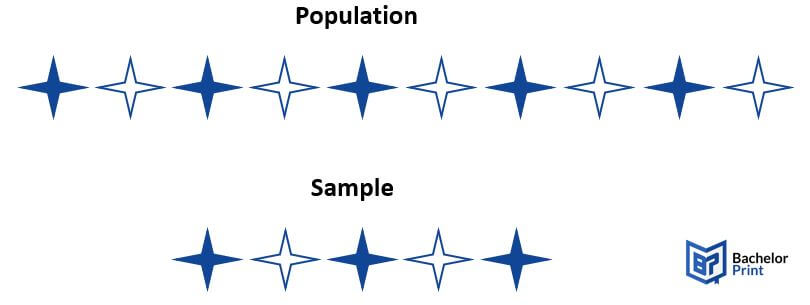
If you are studying a group of people, it can be hectic to approach all of them to collect data. As a result, you’ll have to get a sample from the group to help you with the findings. This article will explain the different sampling techniques that will ease your research and help you achieve valid conclusions.
Sampling in a nutshell
- Probability sampling techniques are best for quantitative researches. Given that each individual has a chance to be selected to participate in the study, you’ll have a representation of the whole population.
- Based on how subjective non-probability sampling techniques are, they will be best for qualitative research.
- To have valid findings, you have to be cautious when selecting your sample.
- Before deciding what sampling techniques to use, it would help if you understood the purpose of your studies.
- Test different sampling techniques to help you choose one that is ideal for your study.
Sampling techniques: Definition
When you are studying a large group, you’ll need a sample size to ease the research. It would be best to be critical in your selection as this leads to you having factual findings. The process used in selecting the individuals is sampling techniques.
Population vs sample
The population is the total number of individuals you are aiming to base your study on. On the other hand, a sample is a group you’ll be required to choose from the population to help you get the days you need for your study.
Therefore, if you are studying a company with 100 employees, that is your focus population. To collect data, you’ll need at least 25 employees who make up the sample size of your research.

Probability sampling techniques
This type of sampling techniques maximizes the random selection. This implies that each individual in the group has an equal chance of participating in the research.
Simple random sampling techniques
This is a technique where each individual in the population has an equal chance of being chosen. In other words, it is a matter of luck or chance. To use this sampling technique, you first list the entire group, let’s say 100. You’ll then have to allocate numbers to each individual. You also need to decide on the sample size you want to work with.
It would be best that you work with a number generator software. It will help you pick random numbers of individuals. From that, you’ll have a sample for your study.
Systematic sampling
This is the correct sampling technique to use for your research if you do not have the list of the population you are conducting your study on. Therefore, you’ll begin your selection from a random starting point. You’ll also need to have a sampling interval.
To have the interval, you’ll need to divide the population by the sample size you need. Therefore if you have a population size of 100 and need a sample of 25, the sampling interval will be 4. Therefore, every fourth individual will be part of your sample size.
Stratified sampling
For this sampling techniques, you’ll have to divide the population into sub-groups. You need to ensure that each member of the sub-populations has the same attributes. These sub-populations can also be called strata.
Once you have the different groups, you’ll be required to use another probably sampling such as simple random sampling. You then get to pick some individuals from each stratum to form your sample.
For example, if you have a population size of 100, you can divide them into five sub-groups. You’ll then select five individuals from the sub-populations to give you a sample of 25.
Cluster sampling
Just like stratified sampling, you’ll have to divide the population into smaller groups. For this method, the smaller groups are known as a cluster. You have to ensure that the individuals forming the clusters are heterogeneous. This implies that they all have different characteristics. This means that each set is a representation of the whole population.
For example, if working with a population of 100 individuals, you can decide them into 5 clusters. Since the clusters represent the entire group, you can choose one and use it as your sample.
in Your Thesis
Non-probability sampling techniques
Unlike in probability sampling techniques where you can calculate your sample size, you cannot calculate in non-probability sampling. You get to choose the sample of the study based on your subjective judgement. In other words, not all the individuals in the population have a fair chance of being selected.
Convenience sampling
This is a sampling technique where you get a sample for your study from the population closest to you. This is one of the easiest sampling techniques as you work with individuals conveniently available for you. The diagram will help you understand better.
Let’s say you want to do a study about students in your university or college. Going from a lecture room to another is hectic. The easiest thing to do will be to reach out to your college mates to collect the samples you need.
Voluntary response sampling
For this sampling technique, you’ll have participants who are willing to give an input on the topic. One drawback about this type of sampling is that it is not a representation of the whole population. This is because each participant feels in the survey based on what they think is appropriate for them.
For example, you are doing a study on whether university students are impressed with the school. Each participant will give findings on how they feel, which might not represent the whole population in the university.
Purposive sampling
This is another example of non-probability sampling techniques where you can use your judgement to decide on the participants you want for your study. Before looking for participants for your research, you need to understand your research’s aim. This is key to helping you find individuals that will help you come up with significant a conclusion.
Let’s take a case where you are doing a study about a specific religious belief. The right step will be to pick participants who have a vast knowledge of the faith. With this, you are sure to have facts from your research.
Snowball sampling
If you have are samples with unique traits, it can be challenging to find more. In such a case, you can ask for referrals from the individuals you already have for your study. In the end, you’ll have a large sample size that is beneficial for your findings.
An example is when you are researching persons with a unique disease. You might have no idea who are other eligible individuals to include in your study. For this, you can use the initial recruits to get other people suffering from the same illness.
- ✓ Free express delivery
- ✓ Individual embossing
- ✓ Selection of high-quality bindings
Sampling techniques - FAQ
There are two types of sampling techniques; probability sampling and non-probability sampling. In probability sampling, each person in the group has a chance of being chosen to be part of the research. On the other hand, non-probability sampling is biased. This is because there are factors that will determine the people to be involved in the study.
Tip: If you are done with your academic work, we can help you with thesis printing!
This is the total number of individuals you are studying in your research. Therefore, if you are researching a university, the population size is the total number of students.
As stated above, collecting data from a whole group is a tiresome and confusing process. To avoid such a hustle, you’ll need a sample. The sample size is the number of persons included in the research.
First, you need to understand that the type of sampling techniques you’ll use is dependent on what you are studying and your population size. Common sampling techniques used for qualitative research include purposive, snowball and convenience.
You’ll first start by listing what the goals of your research are. You will then have to identify the sampling techniques that gravitate towards helping you achieve them. Finally, you have to test each to see which is viable for your study.
